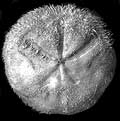The Echinoid Directory
Sarsiaster Mortensen, 1950, p. 155
| Diagnostic Features |
|
|---|---|
| Distribution | Recent, Atlantic; 3120 m. |
| Name gender | masculine |
| Type | Sarsiaster griegii Mortensen, 1950, p. 155, by original designation. |
| Species Included |
|
| Classification and/or Status |
|
| Remarks |
|

